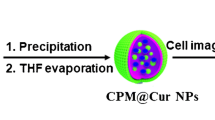Abstract
Herein, a facile way to synthesize Cu nanoclusters (CuNCs) has been proposed while insulin played the role as a stabilizer. Specifically, this type of CuNCs existed in tunable diameters of 4–5 nm, and exhibited bright reddish-orange fluorescence with a quantum yield of 7.4 %. Interestingly, the fluorescence intensity of CuNCs could be obviously enhanced and more stable by introducing Eu3+. Moreover, this proposed Eu3+@CuNCs with low toxicity and near-infrared fluorescence may provide potential to broaden avenues for various applications in bioimaging and beyond.





Similar content being viewed by others
References
Lu YZ, Chen W (2012) Sub-nanometre sized metal clusters: from synthetic challenges to the unique property discoveries. Chem Soc Rev 41:3594–3623
Gonzalez BS, Rodriguez MJ, Blanco C, Rivas J et al (2010) One step synthesis of the smallest photoluminescent and paramagnetic PVP-protected gold atomic clusters. Nano Lett 10:4217–4221
Ingram RS, Hostetler MJ, Murray RW et al (1997) 28 kDa alkanethiolate-protected Au clusters give analogous solution electrochemistry and STM Coulomb staircases. J Am Chem Soc 119:9279–9280
Chen W, Chen SW (2009) Oxygen electroreduction catalyzed by gold nanoclusters: strong core size effects. Angew Chem Int Ed 48:4386–4389
Patel SA, Richards CI, Hsiang JC et al (2008) Water-soluble Ag nanoclusters exhibit strong two-photon-induced fluorescence. J Am Chem Soc 130:11602–11603
Yeh HC, Sharma J, Han JJ et al (2010) A DNA-silver nanocluster probe that fluoresces upon hybridization. Nano Lett 10:3106–3110
Guo SJ, Wang EK (2011) Noble metal nanomaterials: controllable synthesis and application in fuel cells and analytical sensors. Nano Today 6:240–264
Huang X, Luo Y, Li Z, Li BY et al (2011) Biolabeling hematopoietic system cells using near-infrared fluorescent gold nanoclusters. J Phys Chem C 115:16753–16763
Vilar-Vidal N, Rivas J, Lopez-Quintela MA (2012) Size dependent catalytic activity of reusable subnanometer copper(0) clusters. Acs Catal 2:1693–1697
Lu YZ, Wei WT, Chen W (2012) Copper nanoclusters: synthesis, characterization and properties. Chin Sci Bull 57:41–47
Murray RW, Murray RW (2008) Nanoelectrochemistry: metal nanoparticles, nanoelectrodes, and nanopores. Chem Rev 108(7):2688–2720
Vilar-Vidal N, Blanco MC, Lopez-Quintela MA, Rivas J, Serra C (2010) Electrochemical synthesis of very stable photoluminescent copper clusters. J Phys Chem C 114:15924–15930
Bradwell DJ, Osswald S, Wei WF, Barriga SA, Ceder G, Sadoway DR (2011) Recycling ZnTe, CdTe, and other compound semiconductors by ambipolar electrolysis. J Am Chem Soc 133:19971–19975
de la Monte SM, Wands JR (2005) Therapeutic rescue of neurodegeneration in experimental type 3 diabetes: relevance to Alzheimer’s disease. J Alzheimers Dis 7:45–61
Tatar M, Bartke A, Antebi A (2003) The endocrine regulation of aging by insulin-like signals. Science 299:1346–1351
Liu CL, Wu HT, Hsiao YH et al (2011) Insulin-directed synthesis of fluorescent gold nanoclusters: preservation of insulin bioactivity and versatility in cell imaging. Angew Chem Int Ed 50:7056–7060
Balogh L, Tomalia DA (1998) Poly(amidoamine) dendrimer-templated nanocomposites. 1. Synthesis of zerovalent copper nanoclusters. J Am Chem Soc 120:7355–7356
Cheng Y, Shen Z, Zhang Q, Li R, Wei S (2000) Lanthanides’ enhancing absorption of insulin and reduction of blood glucose of rat by pulmonary administration. Chin Sci Bull 45(7):604–608
Li JS, Zhou WY, Ouyang XY, Yu H et al (2011) Design of a room-temperature phosphorescence-based molecular beacon for highly sensitive detection of nucleic acids in biological fluids. Anal Chem 83(4):1356–1362
Acknowledgements
We gratefully acknowledge financial support by Fundamental Research Funds for the Central Universities (XDJK2015A005, XDJK2016D033) and Innovative Research Project for Postgraduate Students of Chongqing (CYS14049).
Author information
Authors and Affiliations
Corresponding author
Ethics declarations
Conflicts of interest
The authors declare no conflict of interest.
Electronic supplementary material
Below is the link to the electronic supplementary material.
Rights and permissions
About this article
Cite this article
Miao, H., Feng, Y., Zhong, D. et al. Enhanced-fluorescence of europium–copper nanoclusters for cell imaging. J Mater Sci 51, 7229–7235 (2016). https://doi.org/10.1007/s10853-016-0006-5
Received:
Accepted:
Published:
Issue Date:
DOI: https://doi.org/10.1007/s10853-016-0006-5




